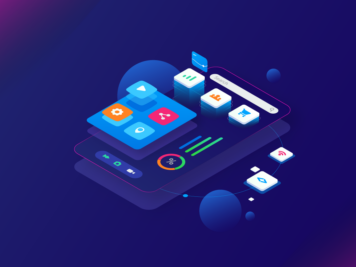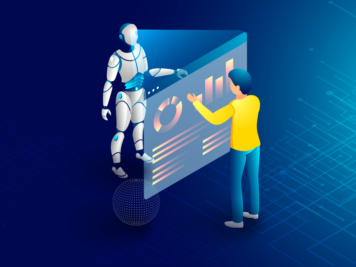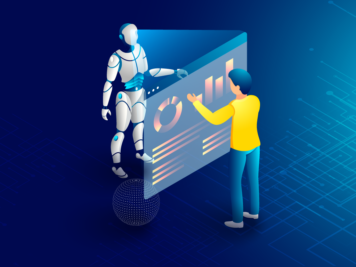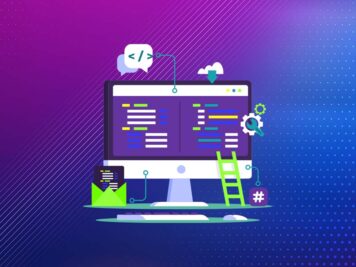Do you feel limited by your current network infrastructure? Are you struggling to keep up with the demands of bandwidth-heavy apps? Traditional cloud-based processing can cause bottlenecks, limiting your ability to respond quickly and obtain actionable insights. However, there is a solution: edge computing applications.
Edge computing applications offer fresh perspective by distributing processing tasks closer to the data source, reducing the load on your core network. In this informative article, learn 5 innovative edge computing applications that can change the game .
Here’s what you’ll learn:
- Edge computing applications can minimize latency in real-time applications.
- How edge computing applications can improve security and privacy.
- Edge computing use cases across various industries.
The Booming Edge Computing Market
Cloud-native offerings have been impacting businesses since the beginning of the previous decade as various applications are getting ample support from technologies like containerization and cloud-native architecture. The predicted valuation of $308.5bn for the public cloud service revenue in 2021 is a good indicator of this evolving market scenario.
In sync with this, the adoption rate of sensor tech and mobiles has been rising and inspiring a tremendous growth in data generation.
However, for network bandwidth, scaling with the same pace is a challenging task, which is creating obstructions for cloud-native processing. And cloud latency is not helping this progress either.
That is why industries are experiencing a paradigmatic shift from cloud-native to edge computing. In fact, Gartner’s 2024 report on Edge Computing underscores this point, highlighting rising interest and adoption across different industries. It also highlights the importance of collaboration in edge computing implementations, as well as how supporting technologies are maturing. So, we can observe various real life edge computing applications.
The IMARC Group’s report reveals that the global edge computing market size reached US$ 14.7 Billion in 2023. Looking forward, they expect the market to reach US$ 90.3 Billion by 2032, exhibiting a Compound Annual Growth Rate (CAGR) of 24.35% during 2024-2032. The leap will be a gigantic one. As its appendage, the edge-native apps industry will also witness a substantial rise.
Engineers design edge-native applications with the edge’s features in mind, so we can expect this growth to be smooth in the coming years. These features have earned some advantages for the technology-
Advantages of Edge Computing Technology
Latency
Edge computing can process data near the source and prioritize traffic. This helps reduce data flow to and fro from the primary network and increases processing speed, making data more relevant.
Security
Data goes to the cloud analyzer through a single pipe in a cloud-native setup. If it is compromised, then the entire work of an organization can come to a standstill. With edge computing, such chances are less as hackers can access only a limited amount of data.
Reliability
When there is a connectivity issue, storing data locally and ensuring processing are more viable options than the traditional modes.
Cost-effective
Better segregation of data leads to better data management and reduces cost. Edge computing makes it easier and optimizes the use of the cloud and available bandwidth.
Scaling
Scaling between Edge and Cloud is an ability that helps edge computing manage data volume. The system is designed to ensure a balance and maximize output.
But what are the fields that stand to benefit from networks moving nearer to the edge?
While assessing various aspects, I realized that the changing dynamics of IoT and 5G technologies have the potential to impact more. However, with companies like Vodafone, Ericsson, and Huawei fast-tracking their architectural changes to accommodate 5G advancements, the chances of edge computing percolating industries are growing bigger.
Edge computing vs. cloud computing
Before going into more details about edge computing applications, let’s first understand how edge computing is different from conventional cloud computing:
| Feature | Edge computing | Cloud Computing |
|---|---|---|
| Processing location | Data is processed closer to its source | Data is processed in centralized data centers |
| Latency | Lower latency due to local processing | Higher latency due to data travel |
| Bandwidth Usage | Less bandwidth usage due to less data transmission | Higher bandwidth usage due to data transmission |
| Security | Potentially more secure due to less data exposure | It is based on centralized security measures |
| Scalability | Scaling resources is more complex | It is easier to scale resources |
| Data privacy | Local storage can offer data privacy | Data privacy depends on the security of the cloud provider |
| Cost | Potentially lower costs due to reduced bandwidth | Cost-effectiveness depends on consumption |
| Applications | Real-time applications, AR/VR, IoT and Industry 4.0 | Large-scale data analysis and business applications |
Edge Computing Applications:
Based on the above factors, we have identified a few use cases that are most suitable for edge computing applications.
1. Video Processing
Cisco’s Global Cloud Index reveals some interesting aspects that shed light on why edge computing will gain ground in the coming years. According to the index, people, machines, and IoT will generate around 850 Zettabytes (ZB) by 2021. So video processing is one of the potential edge computing applications.
Only 10% of this will be useful and will be 10X greater than the stored or used data (7.2 ZB) in 2021. The report also reveals that the useful data may exceed “data center traffic (21 ZB per year) by a factor of four”.
Among the data generated, a huge part is getting churned from video streaming as the streaming industry has seen a substantial hike in revenues during the COVID-19 pandemic.
In the US, the rise in people using a streaming site has grown 21% since 2018. Streaming platforms are now at loggerhead to improve user experience and for that, they are moving to better image quality. This will trigger a massive change in edge computing engagement.
But streaming is not the only point of concern. Interactive videos may also find edge computing’s use quite alluring as these can help businesses thrive by providing immediate results.
The other area that might benefit from edge computing is content suggestions. Predictive analysis is gaining momentum to generate content for the targeted audience. With the help of edge computing, companies can do it locally and increase the speed of suggestions to ensure better engagement.
The segment will benefit more from a teaming up of technologies like edge computing, AI and machine learning. Real-time personalization of data, customer data review, and behavior analytics to deliver actionable insights will become easier.
2. AR/ VR
AR/ VR is an innovation that is set to transform how we consume content. Its ability to provide immersive experiences is expected to engage more customers than ever.
However, the process is not simple. It requires proper stitching of real-world and a user’s motion in a digital world to ensure adequate synchronization. But this will trigger a need for a huge volume of the graphical rendering process.
To ensure the seamless functioning, splitting the workload between AR/ VR, and the edge is necessary. The process has latency-sensitive moves, which can be controlled if the edge takes over and handles the bandwidth issues by introducing a semblance in its use.
The use of AR/ VR in the retail space would be significant as it can transform the traditional brick-and-mortar experience. People can now enter a mall and get a customized route plan or buying chart in a grocery store based on their previous buying experience there. In addition, generating online content will become easier with edge computing services.
The burgeoning gaming sector will also benefit from edge computing as it can reduce the price of AR/ VR gears by taking over the image rendering capabilities. Advanced computing capabilities will take a backseat with the edge taking over the data rendering process. It will also increase the rendering opportunities.
Edge computing will allow end users to play a game using either a normal and heavier headset or a lighter device. By providing gamers with such options, it can boost the adoption rate for the AR/ VR gaming industry.
In fact, the impact of the combined force of AR/ VR and edge computing is going to be much wider including “serious gaming” use cases. Doctors with AR glasses can perform critical surgeries with overlaid X-ray reports or other physiological maps and it will be a huge boost for the healthcare sector.
For firefighters and soldiers, situational awareness is of utmost importance to chalk out their moves, including seeking guidance from their handlers. Advanced AR/ VR designs with edge computing can strengthen their steps by providing vision with extrasensory capabilities, better situational awareness, improved risk calculation, temperature reading, and improving decision-making.
3. Emergency Services
Emergency services in the healthcare sector are going local to reach out more to people in distress. It is not always possible for patients in emergencies to visit a multispecialty hospital at a distance. To counter this, equipping the ambulance with adequate measures is a far better idea.
Edge computing and 5G technologies are a perfect combination for such scenarios. Making it one of the edge computing applications. A blend of technological and computational resources will accelerate diagnosis and analytics and help the medical team work efficiently within the golden hour.
The medical wearable segment is witnessing investments pouring in from several sectors, which means an increased scope for research and adoption of new technologies. The connected medical devices segment that helps diagnose, monitor, and treat patients has the potentials to scale up to $52.2bn by 2022.
Such devices generate a massive amount of data and a huge portion of it requires real-time processing to ensure faster treatment. For instance, healthcare IT architectures can benefit by gathering health-related data. Simultaneously, it can develop rapidly, real-time analytics using edge computing to predict health emergencies and take actions accordingly.
IoT medical devices can detect anomalies, notify concerned authorities, and save time to allow doctors extra time to save a person’s life.
IoT and edge computing technologies can provide extra security in smart homes and cities in terms of emergency services. A smart tool like a security camera can process images and recognize voice to understand unwanted activities at the edge. It will help prevent leakage of private and sensitive data from audio and video devices.
4. Preventive Measures
Edge computing has a massive role to play in preventing acts of terrorism. Security footages from various points are continuously uploading images to the cloud or a server for a better analysis. And the bulk is getting bigger with each passing day.
But if those can be analyzed at the edge using Deep Learning models, then officials can take action much faster and stop major crimes from happening.
In fact, the outbreak of the COVID-19 is an eye-opener in many ways. Scanning people and products, then uploading details and wait for the results to come to consume a lot of time. Such delays in a pandemic situation are unacceptable.
However, edge computing and the 5G network can change the scenario by increasing the assessment speed and reducing the waiting period.
5. Industry 4.0
The industrial revolution has entered the 4.0 phase and its focus is on improving productivity by transforming the workforce and bolstering industrial growth by making economics more impacting. Such an overhaul is depending a lot on IoT adoption. Just in the manufacturing sector, the IIoT market spending is predicted to grow from $1.67bn in 2018 to $12.44bn in 2024.
The demand for better security and seamless operation will go up in sync with the expanding market.
As an integral part of IIoT, automation will gain big from a paradigmatic shift in procedures that edge computing promises.
Automation generates a massive amount of data, which can be used for AI-based analytics like predictive maintenance or reducing downtime etc. IIoT generated data is sensitive and industries might become reluctant to send and store data remotely over the cloud.
But with edge computing, data persistence and analytics can be done closer to data source ensuring data privacy and security.
Simultaneously, the storing of data on a local scale will help companies more in adhering to policies like GDPR. By enabling decentralization of specific processes and ensuring optimal physical location, edge computing will create IoT deployments that are more secure, reliable, and scalable.
Interestingly, this move will not be a restrictive one; rather, it will open up avenues for IoT applications. Industries like smart homes and healthcare will benefit from it.
Conclusion
The rising influx of rich data in these five areas is inspiring moves that focus more on actionable insights and process optimization. In sync, there is a hike in demand for safety and security.
These strategic mechanisms are getting substantial attention from governments and private investors, and it is a boon for edge computing. The coming years will witness more of edge computing applications and these five aspects.
Several forces are coming together to shape this future. Advanced technologies such as Safe Access Service Edge (SASE), Zero Trust Network Access (ZTNA), and Kubernetes (K8s) will enable secure and efficient edge data processing. The rollout of 5G and upcoming 6G networks will deliver the high-speed connectivity needed to fully realize the potential of edge computing.
Additionally, a vibrant ecosystem of players drives innovation and adoption. Each player in the edge computing ecosystem, from telecom operators and cloud giants to equipment vendors and IT providers, adds a different piece to the puzzle. As this ecosystem grows and technology evolves, the potential uses of edge computing will expand across all sectors, revolutionizing the way we live, work and interact with our environment.
FAQs
What are some popular edge computing use cases (or examples)?
Edge computing applications are emerging across various industries. Real-world applications include video processing for content delivery networks, augmented reality (AR) experiences in retail, and sensor-based preventive maintenance in manufacturing.
How is edge computing different from cloud computing? (Edge computing vs. cloud computing)
Both technologies process data, but their locations differ. Cloud computing centralizes processing in data centers, while edge computing brings it closer to the data source, resulting in lower latency and bandwidth utilization.
What are the essential characteristics of edge computing architecture?
Features of edge computing often include low-power processing units, local storage capabilities, and networking to communicate with the cloud or other edge devices. This architecture enables real-time processing and decision-making at the edge.
How does edge computing work?
Edge computing devices collect and analyze data locally. Based on pre-programmed rules or artificial intelligence models, these devices can make judgments or send filtered data to the cloud for further processing. This two-tier approach maximizes efficiency while reducing reliance on centralized resources.
What types of devices are used in edge computing?
Edge devices take many forms, including smart sensors, industrial controls, wearable devices, and even smartphones. These devices can collect, process, and potentially send data across the perimeter network.










